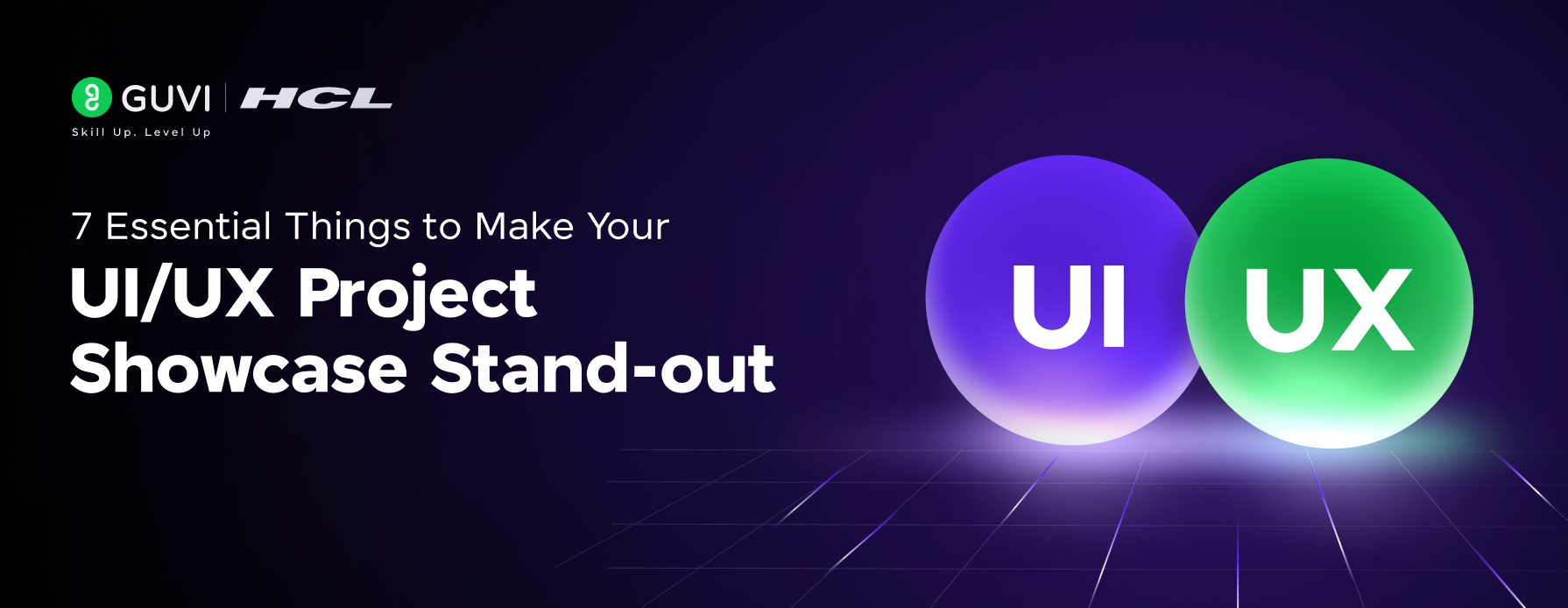
Minimalism in UI/UX Design: Role and Importance for Design Career
Mar 01, 2025 6 Min Read 4280 Views
(Last Updated)
You might have heard the term ‘minimalism’ before – it’s all about keeping things simple and not using more than you need. In the world of design, this means creating clean, clear, and uncomplicated designs.
In this blog, we’re going to talk about what minimalism means in design. We’ll look at why it’s popular and how it’s changed the way things are designed, from websites to posters and even buildings. It’s not just about how things look – it’s about making them easy and clear to use and understand.
If you’re a designer or just interested in design, knowing about minimalism is important. It can help you create better work, make your designs stand out, and even make your job easier. So, let’s get started and learn all about minimalism in design and why it’s such a big deal for anyone in the design world!
Table of contents
- What is Minimalism in Design?
- The Role of Minimalism in Design
- Shaping User Experience
- Impact on Aesthetics and Functionality
- Minimalism in Various Design Fields
- How is Minimalism Important for Your Design Career?
- Enhancing User Engagement and Usability
- Focus on Core Content and Functionality
- Minimalism as a Response to Information Overload and Design Complexity
- Key Elements in Minimalist Design
- Simple, Clean Design with Lots of Negative Space
- Purposeful Elements
- Few Colors
- Balance
- Simple Typography
- Best Practices of Minimalism in Design
- Integrating Minimalist Principles Effectively
- Balancing Minimalism with Brand Identity and Creativity
- Avoiding Common Pitfalls in Minimalist Design
- Conclusion
- FAQs
- What exactly is minimalism in design?
- Why is minimalism important in a design career?
- Can minimalism be applied to all types of design?
What is Minimalism in Design?
Minimalism in design is a concept centered around the idea of using only the essential elements in a design. It’s about simplicity, clean lines, and a monochromatic color palette, with the overall aim of creating a tranquil, uncluttered space. The mantra of minimalism is “less is more,” emphasizing the idea that removing excess elements can lead to more effective design.
- Minimalism originated in the post-World War II Western art world, particularly in American visual arts in the 1960s.
- The movement was a reaction against the complexity and excess of abstract expressionism.
- It was heavily influenced by Japanese traditional design and architecture, which emphasized simplicity and natural beauty.
- In the late 20th century, minimalism extended into various design fields, including architecture, interior design, and graphic design.
As we proceed to the next phase, make sure you understand the fundamentals of UI/UX, which includes heuristic analysis, journey maps, testing, etc. If you want to explore more about it, join GUVI’s UI/UX Course with placement assistance. You’ll also learn about the tools used in UI/UX which are AdobeXd, Illustrator, Photoshop, Figma, and many more. Build some amazing real-time projects to get hands-on experience.
Also, if you want to explore Figma through a Self-paced course, try GUVI’s Figma certification course.
Unlike maximalism, which thrives on abundance and extravagance, minimalism uses fewer elements to create a serene and more direct message. In contrast to art deco, which embraces rich colors, bold geometry, and intricate details, minimalism relies on understated hues and simple forms. Compared to industrial design, which often exposes the building elements and raw materials, minimalism tends to hide these in favor of a cleaner look.

Next, let’s talk about the role of minimalism in design. Now, we’ll see how this simple and clean style makes a big difference in how things are designed and used, and why so many people like it.
Also Know the Top 12 Key UI/UX Design Principles
The Role of Minimalism in Design
Minimalism plays a significant role in shaping both the aesthetic and functional aspects of design across various fields. Its influence extends from tangible products to digital interfaces, impacting how users interact with and perceive designs.
1. Shaping User Experience
By stripping away non-essential elements, minimalism makes designs more understandable and easier to use. Users can navigate more intuitively, focusing on the core functionality without being distracted by superfluous details.
Minimalist designs help reduce the amount of processing power required to understand a product or interface. This is particularly important in an age where users are bombarded with information and choices.
Minimalist designs often evoke a sense of calm and serenity. They can create an environment that feels clean, orderly, and well-managed, which can be psychologically pleasing to users.
Learn User Flow in UX Design: 11 Important Steps to Look After
2. Impact on Aesthetics and Functionality
Minimalism favors a clean, uncluttered look that has a timeless appeal. It often leads to designs that are elegant and modern. By focusing on essential elements, minimalist design often results in improved functionality. There’s a strong emphasis on each element’s purpose, leading to a more efficient and user-centric design.
Minimalist design can contribute to sustainability by reducing the unnecessary use of materials and resources. This approach aligns with eco-friendly design principles.
3. Minimalism in Various Design Fields
- Graphic Design: In graphic design, minimalism manifests through the use of simple imagery, limited color palettes, and ample white space. It’s about conveying a message in the most straightforward and impactful way possible.
- Web Design: Minimalist web design focuses on user experience. It typically involves a clean layout, intuitive navigation, and content that’s easy to digest. The goal is to enhance usability and ensure the website is accessible and straightforward.
- Product Design: Minimalism in product design is about creating products that are both aesthetically pleasing and functional, without unnecessary embellishments. It often results in products that are user-friendly and easy to operate.
Minimalism in design goes beyond just a visual style; it’s a philosophy that places the user’s needs at the forefront, ensuring that every design decision, from aesthetics to functionality, is made with purpose and clarity.

Also Read | Top 10 UI Design Patterns: Creating Intuitive and Engaging User Experiences
After learning the role of minimalism in design, let’s talk about why it’s the key to your success in a design career.
How is Minimalism Important for Your Design Career?
Adopting a minimalist approach in your design career can have profound effects on your work’s impact and effectiveness. Here’s how minimalism can enhance your career as a designer:
1. Enhancing User Engagement and Usability
By creating designs that are simple and intuitive, you significantly improve the user experience. Users are more likely to engage with a design that is easy to understand and interact with. Minimalist designs are often more accessible.
By reducing visual clutter, you make it easier for users with various abilities to navigate and use your designs. Clean, straightforward designs can help build trust with your audience. Users often associate minimalist designs with professionalism and reliability.
2. Focus on Core Content and Functionality
Minimalism teaches you to focus on what’s truly important in your design. By eliminating unnecessary elements, you can highlight the core content and functionality, making them the focal point. When you focus on the essentials, you’re often able to find more efficient solutions to design problems. This approach can lead to innovative and creative outcomes.
A minimalist approach can make your designs more adaptable across different platforms and devices, an essential skill in today’s multi-platform world.
3. Minimalism as a Response to Information Overload and Design Complexity
In an age where users are constantly bombarded with information, minimalism offers a way to simplify complex information, making it more digestible and easier to understand. Minimalist design can help your work stand out. It offers a clean, refreshing contrast to more complex and busy designs.
Minimalist designs tend to be more timeless and less subject to trends, ensuring your work remains relevant and effective for a longer period.
Incorporating minimalism into your design philosophy can make you a more effective and adaptable designer. It not only improves the aesthetic quality of your work but also enhances its usability and relevance in the current design landscape. As a result, embracing minimalism can be a key factor in advancing your design career.

Also Read: Why Should You Become a UI/UX Designer: Top 10 Reasons
Now that we’ve seen why minimalism is important for your career in design, let’s look at what makes it special. Next, we’ll talk about the main elements of minimalist design and how they help you make great designs.
Key Elements in Minimalist Design
Minimalist design is characterized by a distinct set of elements that work together to create a clear, uncluttered aesthetic. Here are some of the key components of minimalist design:
1. Simple, Clean Design with Lots of Negative Space
Negative space, or the empty space around and between elements, is important in minimalist design. It creates a visual breathing room, allowing the user’s focus to be drawn to the intended content or elements.
Ample negative space simplifies the interface or layout, making it more navigable and less overwhelming for the user.
2. Purposeful Elements
Every element in a minimalist design should serve a clear and deliberate purpose. This approach avoids unnecessary decoration or elements that don’t contribute to the overall function or message.
The focus on purpose ensures that the aesthetic qualities of the design are aligned with its functionality, resulting in a harmonious and effective outcome.

3. Few Colors
Minimalist design often employs a limited color palette, sometimes even monochrome, to maintain simplicity and coherence.
With fewer colors, the use of contrast becomes more important. This helps in creating focal points and guiding the user’s attention to key elements.
Also Explore 9 Important Things of Color Theory in UI Design That You Shouldn’t Miss
4. Balance
Achieving balance with minimal elements is a critical aspect of minimalist design. It involves the thoughtful arrangement of these elements to create a sense of stability and harmony.
Both symmetrical and asymmetrical designs can achieve balance. The key is how elements are distributed in the space, ensuring that no single part of the design overpowers the others.
5. Simple Typography
Typography in minimalist design should be simple and legible. It’s not just about choosing the right font but also about how text is laid out and spaced.
Effective use of typographic hierarchy (such as headings, subheadings, and body text) is essential in minimalist design. This helps in guiding the user’s attention and making the content easy to scan.
These elements, when combined effectively, create a design that is aesthetically pleasing, functional, and user-friendly. Minimalist design is not about the absence of elements, but rather the perfect balance and alignment of the essential components to convey a message or functionality in the most efficient way possible.

Also Read: Typography in User Interfaces: Basic Guide for Beginners [2024]
Now that we’ve looked at the important elements of minimalist design, let’s move on to the next section. Here, we’ll talk about the best practices to use minimalism in design. We’ll learn how to make designs simple and beautiful, following the main ideas of minimalism.
Best Practices of Minimalism in Design
Adopting minimalism in design involves more than just reducing elements. It’s about thoughtful reduction and strategic design choices. Here are some best practices to effectively incorporate minimalism into your design work:
1. Integrating Minimalist Principles Effectively
Before applying minimalism, it’s important to understand its core principles like simplicity, functionality, and emphasis on negative space.
Identify what is essential in your design and eliminate elements that do not serve a specific purpose or add value. Apply minimalist principles consistently across all aspects of your design to maintain coherence and integrity.

2. Balancing Minimalism with Brand Identity and Creativity
Ensure that your minimalist design aligns with the brand’s identity and values. It should enhance the brand message, not overshadow it. Minimalism doesn’t mean your design has to be boring.
Experiment with creative layouts, typography, and color schemes within the minimalist framework to create unique and compelling designs. Add a personal or unique touch to your designs to make them stand out, even within the minimalist paradigm.
3. Avoiding Common Pitfalls in Minimalist Design
- Over-Simplification: Avoid oversimplifying to the point where the design loses its functionality or fails to communicate the intended message.
- Neglecting User Experience: Always consider how users interact with your design. Minimalism should enhance, not hinder, the user experience.
- Ignoring Context: The context in which the design will be used should guide how minimalist principles are applied. What works for a tech product may not be suitable for a more traditional business.
Successful minimalist design requires a balance between simplicity and functionality, while also keeping in mind the brand identity and user experience. By following these best practices and learning from successful case studies, you can create minimalist designs that are not only aesthetically pleasing but also effective and memorable.

Explore More: UI/UX Best Practices: Creating Exceptional Digital Experiences
Kickstart your UI/UX journey by enrolling in GUVI’s UI/UX Course where you will master technologies like AdobeXd, Illustrator, and Figma, and build interesting real-life UI/UX projects.
Alternatively, if you would like to explore Figma through a Self-paced course, try GUVI’s Figma certification course.
Conclusion
So, if you’re designing something, why not try using minimalism? Keep things simple, focus on what’s necessary, and create designs that are easy and enjoyable to use. This way, you’ll not only make your work look good, but you’ll also make it more useful and popular. Remember, sometimes the simplest designs can be the most powerful!
Also Read About Top UI/UX Design Trends: Embracing Innovation in 2024
FAQs
Minimalism in design is all about using the bare essentials to create a simple, uncluttered, and clean look. It focuses on the idea of ‘less is more’, meaning that you only include what is absolutely necessary for your design.
This could mean using fewer colors, simple shapes, plenty of empty space (also known as ‘white space’), and basic textures. The goal is to create designs that are easy to understand and pleasing to the eye, without any extra decorations or elements that don’t add real value.
Minimalism is important in a design career for several reasons.
First, it helps in creating designs that are timeless and won’t quickly go out of style.
Second, minimalist designs often lead to better user experiences as they are clear, easy to navigate, and don’t overwhelm the user. This can make your work more appealing to clients and users.
Third, by practicing minimalism, you learn to focus on essential elements, improving your skills in decision-making and problem-solving. Finally, in a world filled with information overload, minimalist designs can stand out by offering a clear and focused alternative.
Yes, minimalism can be applied to almost all types of design, including graphic design, web design, product design, interior design, and even fashion design. The key is to understand the basic principles of minimalism – simplicity, functionality, and emphasis on the essentials – and adapt them to the specific needs and goals of your design project.
Minimalism can help you create a design that is both aesthetically pleasing and functionally effective. However, it’s also important to consider the context and the audience, as minimalism might not always be the best approach for every project or client.



















Did you enjoy this article?